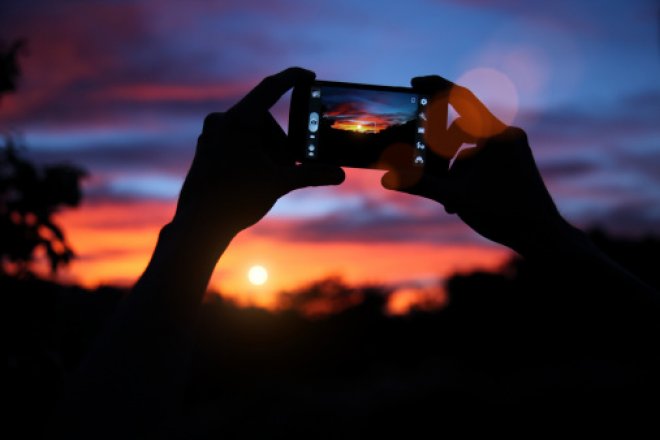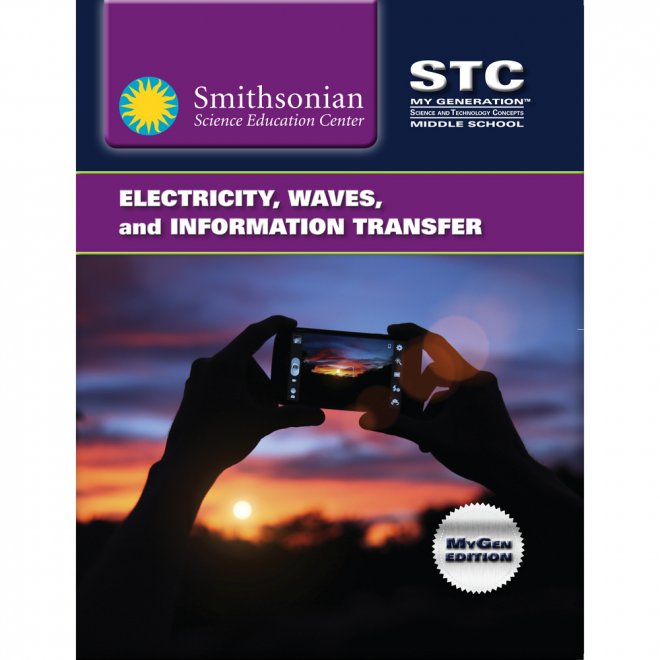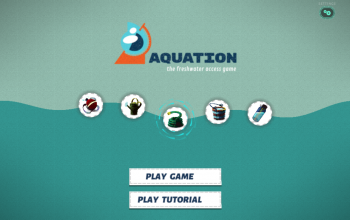STCMS™: Electricity, Waves, and Information Transfer
During the Electricity, Waves, and Information Transfer unit, students design and test real-world technologies, excellent contexts for investigating electricity, information transfer, and waves characteristics. Additionally, electric circuits make excellent models for studying the role of electricity in an animal’s ability to sense and respond to the environment. This unit addresses the 3 dimensions of the Next Generation Science Standards (NGSS) for grades 6 through 8.
You can find all Blackline Masters here. For teacher Lesson Masters and unit Written Assessments, go to Carolina Science Online.
Lesson 1- Battery Powered: Electricity Basics
Language Arts
Challenge students to identify as many items as they can that rely on battery power in their homes. For example, ask them why a clock radio that is plugged into an outlet sometimes has a battery in it as well. Ask students to write a paragraph that describes what devices in their homes use battery power and to speculate on how life would be without batteries.
NGSS: (Supports MS-PS2-3)
Common Core: (WHST.6-8.2
Science
Ask students to use what they learned about electrical systems in Lesson 1 to list ideas about different types of systems (large or small) that rely on an energy source. Have them describe each system in as much detail as possible. Ask them to identify the energy source, what uses the energy from that source, and how is it used. Examples might include food webs that rely on the sun, a car that relies on a battery and fuel, a metro system that relies on electricity and magnetism, or the human body that requires food to stay active.
NGSS: (Supports MS-PS2-1)
Common Core: NA
Social Studies/Art
Have students research the history of the development of dry-cell batteries. Assign them to draw a time line about this history with labeled illustrations, which they will present to the class.
NGSS: (Supports MS-PS2-3)
Common Core: (RST.6-8.1, RST.6-8.7, RST6-8.10)
Technological Design
Have students research the design of batteries with different voltages and purposes. Assign them to put the information in table form with the type of battery, voltage, shape, content (or materials that the batter is made from), and uses. Have students compare their findings in class.
NGSS: (Supports MS-PS2-3)
Common Core: (RST.6-8.7, RST.6-8.9, RST6-8.10)
Technological Design
Have students examine the blueprint for a house. Ask them to describe how a blueprint is like a schematic. Challenge them to try to design a simple schematic for the electrical system in your classroom or for a room in their home.
NGSS: (Supports MS-PS2-3)
Common Core: (RST.6-8.7)
Lesson 2- Resistance and Capacitance
Language Arts
Explain to students that often people and situations are referred to as “powerful” but there is no measure of this “power” like there is for electricity. Have the class discuss why they think the term “powerful” is used to describe situations not relating to energy. Have students write a paragraph about something that is powerful and describe the ways in which that power is conveyed, and what they think is the source of that power.
NGSS: (Supports MS-PS2-2, MS-PS2-3)
Common Core: (WHST.6-8.1C, WHST.6-8.2B, WHST.6-8.2C, WHST.6-8.2D)
Science
Have students measure the temperature change of a resistor in series with the fan. Ask them to describe the energy transformations in this circuit.
NGSS: (Supports MS-PS2-3)
Common Core: NA
Science
Have students hypothesize what would happen to the resistance of their model circuit if they connected both resistors in series and measured the resistance. (Hint: They could do this by dividing the total voltage drop across both resistors by the current in the circuit.) Have students conduct the experiment, and then ask them to explain what happened to the level of resistance. Have them relate if their hypothesis was supported or not and why. They will discover that adding resistors in series increases the total resistance of the circuit.
NGSS: (Supports MS-PS2-3)
Common Core: (RST.6-8.7, RST.6-8.9)
Social Studies/Art
Have students research the development of the first capacitor using Internet and library resources. They should then draw a sketch, with labels, of an example of one of the first capacitors invented.
NGSS: (Supports MS-PS2-3)
Common Core: (RST.6-8.7, RST.6-8.9, RST6-8.10)
Technological Design
Have students use a computer-simulation program to design electrical circuits and to control the current in the circuit.
NGSS: (Supports MS-PS2-3)
Common Core: NA
Lesson 3- Transforming and Transferring Electrical Energy
Science
Galileo had very minimal materials with which to build a thermometer. Ask students to recall what they read in the “Measuring Temperature by Degrees.” Have them hypothesize how they would build a model thermometer using alcohol, tap water, food coloring, a straw, a narrow neck glass bottle, and modeling clay. Have them provide sound scientific reasoning for their design. If there is time have them carry out the experiment and test their models in areas with different temperatures. (Hint: To make a model thermometer the amount of alcohol and water should be in a 50-50 ratio and take up no more than ½ the bottle).
NGSS: (Supports MS-PS3-2, MS-PS3-5)
Common Core: (RST.6-8.7, RST.6-8.9)
Social Studies
Assign students to research the history of the incandescent lightbulb and present an argument for or against its use.
NGSS: (Supports MS-PS3-5)
Common Core: (RST.6-8.8, RST.6-8.9, RST6-8.10)
Technological Design
Have students use Internet resources to research the different types of “heat sinks” that computers use to keep from overheating. Have them name several different types and write a paragraph explaining their functions, how they dissipate thermal energy, and why different types of heat sinks are needed in one computer system.
NGSS: (Supports MS-PS3-3)
Common Core: (RST.6-8.8, RST.6-8.9, RST6-8.10)
Lesson 4- Electricity in Motion
Language Arts
Have students write a short story about how life in the future, 100 years from now, could rely on electromagnetic power. Ideas might include, but are not limited to, electromagnetic cars, trains, walkways, scooters, skateboards, or turbines for energy.
NGSS: (Supports MS-PS3-5)
Common Core: (WHST.6-8.2)
Science
If there is a generating plant or electrical substation in your area, you may want to arrange a field trip so students can see the size of generators and learn about how they work and how companies distribute electrical power. If allowed by your school, have students take cameras and create a short presentation, using their photos, about what they learned.
NGSS: (Supports MS-PS3-5)
Common Core: NA
Social Studies
Have students identify several tasks that were formerly done by human labor but are now done by motors or machines. Ask them to evaluate the impacts on people’s lives of having these tasks done by machines.
NGSS: (Supports MS-PS3-5)
Common Core: NA
Technological Design
Assign students to investigate the differences between AC and DC motors and write a report that describes those differences. If possible, let students look inside an AC motor and a DC motor and compare the parts inside them.
NGSS: (Supports MS-PS3-5)
Common Core: NA
Technological Design
Have students use the Internet, or other means, to find information on current research in motor design, particularly in building nanomotors and machines that work at the molecular scale. Have students explain how the machines and motors work and how they may be applied in the future.
NGSS: (Supports MS-PS3-5)
Common Core: (RST.6-8.9, RST6-8.10)
Lesson 5- Detecting Waves
Science
Assign students to research and evaluate the idea, developed by Einstein, which states that nothing can move faster than the speed of light. Have them develop an argument for or against this idea, using scientific reasoning, and present their idea to the class.
NGSS: (Supports MS-PS4-1, MS-PS4-2)
Common Core: (RST.6-8.8, RST6-8.10)
Science
Explain to students that ospreys, a type of fishing hawk, must learn how to hunt by watching their parents. This involves learning to see fish in the water from high up in the air. When the young osprey dives, it has to learn not to dive right where it sees the fish (even if the fish is holding still). Have students explain why the osprey shouldn’t dive to exactly where it sees the fish if it wants to have a successful catch. Ask the students to use specific scientific evidence from their lessons and discuss their ideas with the class.
Science/Art
Explain to students that many animals see spectrums of light that humans cannot. Have students research the vision of bees and the spectrum of light that they see. Then students should relate the vision of bees to how flowers reflect light, attracting the bees, and what those flowers actually look like to the bees. Students should draw and color sets of flowers. One set should be colored the way that humans might see the colors of the flower and one set the way that a bee would see the colors of the flowers.
NGSS: (Supports MS-PS4-2)
Common Core: (RST.6-8.8)
Science/Art
Have students use fluorescent paints to create paintings and expose them to an ultraviolet light source (or black light). Challenge students to explain their observations.
NGSS: (Supports MS-PS4-2)
Common Core: NA
Lesson 6- Wave Transmission: Traveling Through Media
Science
Ask students to research how sound waves are translated by the human ear into signals that reach the brain. They should present their findings by writing a one paragraph explanation and drawing a labeled diagram or creating a 3-D model.
NGSS: (Supports MS-PS4-2)
Common Core: (RST.6-8.7, RST.6-8.8, RST6-8.10)
Science
Have students repeat part of Newton’s experiment by using a prism to split sunlight. Darken the room, and allow light into the room through a small hole to provide a light beam. Alternately, the experiment can be conducted inside a large cardboard box with sunlight entering the box through a small hole. Have students use their student notebooks to record their results, and then draw and color an illustration of what they discovered.
NGSS: (Supports MS-PS4-2)
Common Core: NA
Science/Language Arts
Rainbows are a common subject for poets. Some thought that Newton’s discoveries destroyed the wonder and romance around this phenomenon. Keats, for example, referred to Newton’s work as a “cold philosophy that unweav[d] the rainbow.” Have students read “Explaining a Rainbow” then search for references to rainbows in poetry. Discuss how these poetic references relate or do not relate to our scientific understanding of how rainbows are formed.
NGSS: (Supports MS-PS4-2, RST6-8.10)
Common Core:
Technological Design
Have students research the difference between light microscopy and electron microscopy and write an explanation about how the two types of magnification differ. Have them explain how images produced by waves of electrons differ from those produced using waves of light.
NGSS: (Supports MS-PS4-2)
Common Core: (RST.6-8.8, RST6-8.10)
Lesson 7- Communicating and Storing Information with Waves
Science/Social Studies
Have students the library and Internet resources to investigate the connection between modern fiber optics, Daniel Colladon, and the Paris Exposition of 1889. They should write a short essay on how these topics are related.
NGSS: (Supports MS-PS4-3)
Common Core: (WHST.6-8.2, RST6-8.10)
Science/Technology
Have students research the role of fiber optics in making the Internet work. They should then draw an illustration, complete with labels, that explains how data travels from source to end point using fiber optics. Alternatively students may choose to demonstrate and explain this process using a computer and fiber optic cables in the classroom.
NGSS: (Supports MS-PS4-3)
Common Core: (RST6-8.10)
Social Studies
Early scientists, such as Galileo, knew about tides, but they did not know how to accurately calculate them. During World War II, Sir William Thomson (later known as Lord Kelvin) developed a basic analog computer to calculate the tides accurately for more precise beach landings of the Allied forces. Have students research Lord Kelvin’s analog predicting machine and write a short historical essay.
NGSS: (Supports MS-PS4-3)
Common Core: (WHST.6-8.2, RST6-8.10)
Technological Design
Ask students to research and write a short paragraph about the properties of an MP3 and how an MP3 compresses music so that more sound or music can be stored in a smaller space than a typical CD.
NGSS: (Supports MS-PS4-3)
Common Core: (RST6-8.1, RST6-8.8, RST6-8.10)
Lesson 8- Waves and Information Transfer: The Global Positioning System
Language Arts
Challenge students to consider the many different ways that people use weather forecasts and predictions from satellites and computer models. Ask them to write one paragraph describing some of these applications and another paragraph speculating what life would be like without the technology to predict weather.
NGSS: (Supports MS-PS4-2, MS-PS4-3)
Common Core: (RST6-8.2, WHST.6-8.2, RST6-8.10)
Science
There are many different satellites in orbit over Earth at any given time. Have students use the Internet to research which satellites are overhead at the time they are conducting their research. Have them make a list and include as much information about each satellite as possible. This may include information such as the name, country of origin, launch date, transit time, direction, and purpose of the satellites. (Hint: Students can put in the phrase “what satellites are overhead right now” in a search engine to find this information).
NGSS: (Supports MS-PS4-2, MS-PS4-3)
Common Core: NA
Science/Social Studies
GPS has become an integral part of disaster relief and recovery operations. Have students research the different ways that GPS may be used for these purposes and write a one or two paragraph explanation.
NGSS: (Supports MS-PS4-2, MS-PS4-3)
Common Core: (RST6.8-2, RST6-8.10)
Technological Design
Most GPS units use trilateration (three satellites) to find a particular set of coordinates, though four satellites are suggested for optimal accuracy. Have students create a model, or diagram, to demonstrate why four satellites are more accurate than three. Have them explain their model to the class.
NGSS: (Supports MS-PS4-2, MS-PS4-3)
Common Core: (RST.6-8.7, RST.6-8.8)
Lesson 9- The Electric Body
Language Arts/Social Studies
Have students imagine what it would be like for a deaf person to receive a cochlear implant and to hear for the first time. Assign students to write a short story to speculate what this experience would be like.
NGSS: (Supports MS-PS4-1, MS-PS4-2)
Common Core: (RST6-8.2, WHST.6-8.2)
Science
Instruct students to break into two groups. Each group will work together to create and demonstrate a model that shows action potential traveling down a neuron. They may use other students as different parts of the neurons and a ball or object to represent the electrical signal. Students should demonstrate a strong and weak sensory signal and explain their model.
NGSS: (Supports MS-PS4-1, MS-PS4-2)
Common Core: NA
Science
Great white sharks are not easily kept in aquariums, and some theorize that this may be in part due to the electric motors required to run the filters and pumps of their environments. Have students research why electrical stimulus might be detrimental to the sharks. Assign the students the role of an aquarium designer hired to design a large aquarium to accommodate sharks without over stimulus from electrical fields. They should write a proposal and draw their aquarium design, with labels. Proposals should be presented to the class and evaluated by the students for the best designs.
NGSS: (Supports MS-PS4-1, MS-PS4-2)
Common Core: (RST.6-8.7, RST.6-8.8, RST6-8.10)
Technological Design
Have students research how cochlear implants help people who are deaf hear. Ask students to write one or two paragraphs about how the implants work and how sound is translated to the brain of the person with the implants.
NGSS: (Supports MS-PS4-1, MS-PS4-2)
Common Core: (RST6-8.2, RST6-8.10)
Lesson 10- Animal Navigation and Navigation Systems
Language Arts
Assign students to work in pairs and have the entire class to use the first verse of a common nursery rhyme for this exercise. Ask each pair of students to list all the words in the nursery rhyme on a piece of paper. Each student should take turns articulating each word very slowly. They should try to notice where the word is “felt” or formed in their vocal tract, from their throat and tongues, to how the tongue is shaped, and how the lips move. Partners can also help describe lip shape, throat movement, and cheek movement for their partners. Have student write short descriptions of each word and identify any patterns that they see in the shaping and articulation of the words.
NGSS: (Supports MS-PS4-1, MS-PS4-2)
Common Core: NA
Science
Unlike humans, whose ear canals are directly across from each other, many species of nocturnal owls have ear holes that are asymmetrical. One ear aperture is higher than the other. The ears of these owls are under a thin layer of feathers, just behind their facial discs. Have students hypothesize how this configuration is used for picking up sound waves and finding prey. Students should write a short paragraph and use illustrations to demonstrate their theory. Explanations should include ideas such as triangulation from the asymmetrical placement of the ears and the cupped shape of the face being used for picking up sound.
NGSS: (Supports MS-PS4-1, MS-PS4-2)
Common Core: (RST-6.8.7, RST6-8.10)
Science
Have students research the parts of the brain responsible for human speech and present their findings to the class.
NGSS: (Supports MS-PS4-1, MS-PS4-2)
Common Core: (RST6-8.2, RST6-8.10)
Science
Ask students to recall what they read about dolphins and echolocation. Explain that most dolphins travel in pods of twenty or fewer dolphins, but sometimes they congregate in larger groups of 100 or more. With all the dolphins in such close proximity, their echolocation signals are overlapping and many may use the same frequency of clicks and squeaks. Dolphins need to hear their echolocation signals to move around or they might run into each other or miss their prey. Ask students to hypothesize how the dolphins could navigate in such a large pod and keep from running into each other, find prey, or find specific members of their pod (using sound signals) when there is so much echolocation interference.
NGSS: (Supports MS-PS4-1, MS-PS4-2)
Common Core: NA
Technological Design
Researchers use detectors to record and visualize the echolocation calls of bats, which are mostly above the hearing range of humans. Have students use Internet or library resources to research how bat detectors work, and then suggest specific measurable parameters that researchers may measure when identifying and sorting the calls of specific species of bats. Ideas might include call duration, call patterns, median frequency of each call, maximum and minimum frequency, call modulation, or the presence of feeding buzzes and clicks.
NGSS: (Supports MS-PS4-1, MS-PS4-2, MS-PS-4-3)
Common Core: (RST6-8.10)
Lesson 11- Electricity Waves and Medical Technology
Science
Have students take on the role of consulting archaeologists studying the mummy Ötzi the Iceman, which was found frozen in the Alps. Ask students to research Ötzi and write one or two paragraphs describing which imaging technologies they would use to study the mummy, so as to be minimally invasive, and how these images could be applied in understanding his life and death. Have students share their ideas with the class.
NGSS: (Supports MS-PS4-1, MS-PS4-2, MS-PS4-3, MS-LS1-8)
Common Core: (RST6-8.2, RST6-8.10)
Science
Have students research which metal most effectively deflects X-rays and is used in shields when doctors take X-rays of patients. Ask students to explain why the shielding of body parts that not being X-rayed, using this type of metal, is necessary.
NGSS: (Supports MS-PS4-1, MS-PS4-2, MS-PS4-3, MS-LS1-8)
Common Core: (RST6-8.2, RST6-8.10)
Technological Design
Have students research 3-D printers using the Internet and hypothesize how the 3-D printers could be used, in conjunction with the images from CT scanners, to help in the medical field. Ideas might include training for doctors, imaging a 3-D model to help surgeons visualize a surgery, or printing a “body part” with real cells from the human body.
NGSS: (Supports MS-PS4-1, MS-PS4-2, MS-PS4-3, MS-LS1-8)
Common Core: (RST6-8.2, RST6-8.10)
Lesson 12-Exploring and Desiging Touch Screen Devices
Language Arts
Have students write a short story about what they think the future will be like, and technologies that humans may use, 100 years from now. Be sure to have students include ideas about computers, touch screens, and how humans will share and learn information.
NGSS: (MS-PS4-3)
Common Core: (RST6-8.2, WHST.6-8.2)
Science
Have students research and explain the electrostatic forces that buildup and cause lightening. They should choose one type of lightening, such as cloud to cloud or cloud to ground, and then write an explanatory paragraph. They may use a model or illustrations to support their findings.
NGSS: (Supports s MS-PS4-2, MS-PS4-3, MS-ETS-1, MS-ETS-2, MS-ETS-3, MS-ETS-4)
Common Core: (RST6-8.2, RST6-8.10)
Social Studies
Optical touch screen technology, which uses two to four cameras mounted in the corners of a screen or device, track touches on a screen and do not require capacitive or resistive force. Have students create a chart with the pros and cons that they think these three types of touch screen technologies may offer in different environments or situations such as in the classroom, home, or using a smartphone.
NGSS: (Supports s MS-PS4-2, MS-PS4-3, MS-ETS-1, MS-ETS-2, MS-ETS-3, MS-ETS-4)
Common Core: (RST6-8.2, RST6-8.10)
Technological Design
Biomimicry is an emerging field of engineering and applied science. Biomimicry researchers are studying Morpho butterflies because the scales on their wings reflect light in bright and dim environments. Many touch screens, with digital displays, cannot be seen in bright light. Have students use the Internet to research how iridescent butterfly wings, like the Morphos’, reflect light in changing conditions. Then have them develop a hypothesis about how butterfly wing scale design could be mimicked in touch screen technology to reduce energy use and allow touch screens to be viewed even in bright sunlight.
NGSS: (Supports s MS-PS4-2, MS-PS4-3, MS-ETS-1, MS-ETS-2, MS-ETS-3, MS-ETS-4)
Common Core: (RST6-8.2, RST6-8.10)
Lesson 1- Battery Powered: Electricity Basics
Lightning and Lightning Rods
Learn about the Smithsonian's first Secretary, Professor Joseph Henry
Lesson 3- Transforming and Transferring Electrical Energy
Lightning a Revolution
Lesson 4- Electricity in Motion
Learn about Smithsonian's first Secrety, Joesph Henry, and his experiments with magnetism
Lesson 6- Wave Transmission: Traveling Through Media
Mapping the Moon
Lesson 7- Communicating and Storing Information with Waves
And Action: The Ins and Outs of DVD Video Preservation
Read about how the Smithsonian is handling video preservation
Pileated Woodpecker: Listen below to hear a Pileated Woodpecker
Lesson 8- Waves and Information Transfer: The Global Positioning System
How GPS Works
Watch this animation to get a better idea of how GPS works
How Does GPS Work?
Get a deeper understanding of ins and outs of GPS
This video explains how the GPS works and the role of relativity in the system.
Lesson 9-The Electric Body
Sample Sources for Investigation 9.3
How Our Brains Make Memories
Researchers look at how the brain alters memories and how this can help people with post-traumatic stress disorder.
Our Brains Actively Forget Distracting Memories
http://www.wired.co.uk/news/archive/2015-03/18/brains-forget-memories-on-purpose
Forgetting may not be a passive thing, but something the brain does intentionally to help keep memories clear.
Flashes of Light Show How Memories Are Made
http://www.nature.com/news/flashes-of-light-show-how-memories-are-made-1.15330
Scientists use light to show how the brain forms and stores memories.
Researcher Shows How False Memories Are Formed
http://www.northwestern.edu/newscenter/stories/2004/10/kenneth.html
Researchers examine how the brain creates and stores false memories.
Lesson 10- Animal Communication and Navigation Systems
Phonic Lips Image
http://archive.org/stream/nasa_techdoc_19720017412/19720017412#page/n411/mode/2up
This image illustrates that phonic lips are rubbery and stiff.
Video Resources for Lesson 10
Sonar and Seafloor Mapping
http://oceanservice.noaa.gov/education/seafloor-mapping/movies/multi_240.mov
This video from NOAA illustrates sonar’s ability to “paint” a topography and make it visible. This may be useful in helping students understand echolocation.
Laryngoscopy
https://www.youtube.com/watch?v=iYpDwhpILkQ
This video of a laryngoscopy from the University of Iowa Hospitals and Clinics shows how human vocal chords stretch and bunch to make high- and low-frequency sounds.
Lesson 11- Electricty and Waves in Medical Technology
http://www.cfa.harvard.edu/news/2007-07
Sample Sources for Investigation 11.1
Medical X-ray Imaging
http://www.fda.gov/Radiation-EmittingProducts/RadiationEmittingProductsandProcedures/MedicalImaging/MedicalX-Rays/default.htm
Access links to a wealth of information on X-ray imaging, including a description of the technology and risks and benefits.
Pediatric X-ray Imaging
http://www.fda.gov/Radiation-EmittingProducts/RadiationEmittingProductsandProcedures/MedicalImaging/ucm298899.htm
Access links to a wealth of information on pediatric X-ray imaging, including a description of the technology and risks and benefits.
X-rays
http://www.intelihealth.com/print-article/x-rays
A description of an X-ray procedure and its potential risks.
Radiation Dose in X-Ray and Computed Tomography (CT) Exams
http://www.radiologyinfo.org/en/safety/index.cfm?pg=sfty_xray
A description of X-ray exams, radiation dosage associated with X-ray and CT exams, and the risks associated with these procedures.
Computed Tomography
http://www.fda.gov/Radiation-EmittingProducts/RadiationEmittingProductsandProcedures/MedicalImaging/MedicalX-Rays/ucm115317.htm
Access links to a wealth of information on CT scans, including a description of the technology, uses, and risks and benefits.
Computed Tomography Scans and Cancer
http://www.cancer.gov/cancertopics/diagnosis-staging/ct-scans-fact-sheet
An overview of the use of CT scans in diagnosing cancer and the potential risks of the procedure.
CT Scan
http://www.nlm.nih.gov/medlineplus/ency/article/003330.htm
An overview of the CT scan and the risks associated with the procedure.
Magnetic Resonance Imaging (MRI)
http://www.fda.gov/Radiation-EmittingProducts/RadiationEmittingProductsandProcedures/MedicalImaging/ucm200086.htm
Access links to a wealth of information on MRI exams, including a description of the technology, uses, and risks and benefits.
MRI
http://www.nlm.nih.gov/medlineplus/ency/article/003335.htm
An overview of an MRI scan and the risks associated with the procedure.
Patient Safety: Magnetic Resonance Imaging
http://www.radiologyinfo.org/en/safety/index.cfm?pg=sfty_mr
An overview of MRI technology and its safety.
Positron Emitted Tomography (PET) Scan
https://www.nlm.nih.gov/medlineplus/ency/article/003827.htm
Information on how a PET scan is conducted and risks of the procedure.
Positron Emission Tomography
http://my.clevelandclinic.org/services/imaging-institute/imaging-services/hic-pet-scan
A description of the PET scan procedure and associated risks.
Positron Emission Tomography
http://www.hopkinsmedicine.org/healthlibrary/test_procedures/neurological/positron_emission_tomography_pet_scan_92,p07654/
A detailed description of PET and how the procedure works, along with information on potential risks.
Ultrasound Imaging
http://www.fda.gov/Radiation-EmittingProducts/RadiationEmittingProductsandProcedures/MedicalImaging/ucm115357.htm
Access links to a wealth of information on ultrasound imaging, including a description of the technology, uses, and risks and benefits.
Ultrasound
http://www.radiologyinfo.org/en/info.cfm?pg=genus
A description of the ultrasound imaging procedure and the risks and benefits associated with it.
Lesson 12- Exploring and Designing Touch Screen Devices
http://www.smithsonianmag.com/arts-culture/what-happens-when-a-keyboard-goes-from-tactile-to-touchscreen-54507295/
Resources for Building a Prototype Stylus
The following sources provide a variety of suggested materials and designs for the prototype stylus. Refer to the safety warnings on page 224 of the Teacher Edition when collecting materials and guiding students to construct their own prototypes. If you choose to use pens with the ink removed, you may wish to do this part before providing the materials to students.
Stylus Options for iPad and iPhone Users: Do It Yourself
http://atmac.org/stylus-ipad-iphone-custom-diy
How to Make Your Own Stylus with Cotton Ear Buds
http://www.labnol.org/gadgets/make-stylus-pen/19872/
DIY: The 2-minute Stylus
http://www.cnet.com/how-to/diy-the-2-minute-stylus/
Make an Easy DIY Stylus for Your iPhone Using Stuff You Already Have
http://ios.wonderhowto.com/how-to/make-easy-diy-stylus-for-your-iphone-6-6-plus-using-stuff-you-already-have-0156191/





Kit Tips & Tricks